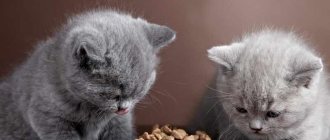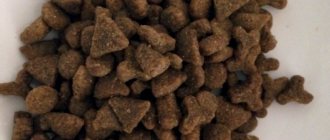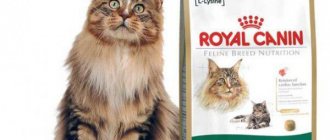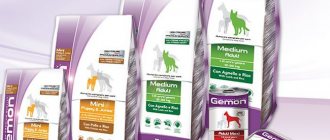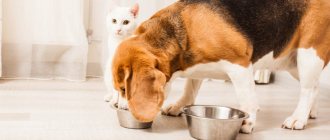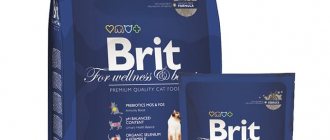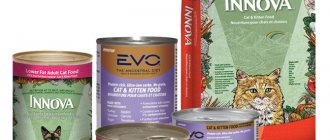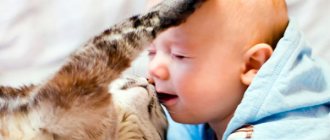More and more people are thinking about their diet, counting calories, vitamins and minerals consumed from foods. What about furry pets? A balanced diet is no less important for animals. Let's, together with the Murkoshi team, find out which cat foods veterinarians recommend purchasing and which ones they advise you to avoid.
1) What should be a good cat food according to veterinarians 2) Classes of cat food 3) What foods should be excluded from the diet 4) What foods do veterinarians recommend
Positive and negative sides
Usually, having brought home a small miracle, the owner gives preference to food prepared independently, thinking that the pet will receive more benefit from it.
But what is the advantage of ready-made food:
- Saving your time. Imagine how many hours you waste by constantly cooking at the stove;
- Balance and nutrients. It doesn’t matter how old your pet is, he will receive all the necessary substances from ready-made food, and in the right proportions and dosages. Due to vitamins and healthy supplements, animals normalize digestion and are less at risk of getting sick;
- Benefit from the purchase. It's a double-edged question. If the food is premium, then self-prepared food will be cheaper;
- Taking care of your teeth. Many foods help in the fight against caries and do not harm the teeth in any way.
There are always negative points:
- If the food is of low quality or budget, the pet will quickly get used to it.
- Such food is very moist, which is detrimental to health.
Some foods do not fight caries, but form it and tartar.
Dry food for kittens that we do not recommend for daily feeding
| Name | Description |
| Hill's Science Plan Healthy Development | The composition is not the worst, there is quite a lot of high-quality protein, namely chicken and turkey flour. But in third place is corn. Corn protein is even less digestible by cats than wheat protein, only 54%. Moreover, pets get only 20-35% of their energy from carbohydrates; they get more than 40% of it from proteins. Therefore, corn should definitely not be the basis of a cat or kitten’s diet. |
| Josera Kitten | The composition, in addition to duck and turkey flour and duck fat, contains corn, rice and corn gluten. |
| Purina One for kittens | The composition is far from ideal. True, 17% chicken comes first, but even here we cannot be sure that this is meat, because... no specifications, followed by dried poultry protein, 14% whole wheat, animal fat, wheat and corn gluten, soy flour, pea protein concentrate, corn starch, dried chicory root, corn, etc. There is also no information on the percentage of components. |
| ProPlan Junior and Kitten | Contains corn and wheat gluten, rice, corn. In first and second place are 20% chicken and dried poultry protein. |
| Royal Canin | After the food was bought by the Mars company and it began to be produced in Russia instead of France, its quality dropped significantly. In other words, its composition is now very similar to economy, despite the presence of different lines, for example, for kittens there is a special milk replacer, food from 1 to 4 months, from 4 months to a year and for sterilized small cats. For example, the first ingredients in MOTHER&BABYCAT food are: dehydrated animal proteins (poultry), animal fats, rice, vegetable protein isolate, grain flour. So, nowhere is there any clarification about what kind of poultry is used, whether it is meat, what kind of rice, what vegetable protein is obtained from, what kind of grain. In general, the composition leaves much to be desired. |
| Cat Chow Kitten | The food is popular due to its affordable price. Reviews from cat owners are mostly positive, however, there are cases where the products provoked an allergic reaction. The composition contains a minimal amount of vitamins and minerals, so the kitten receives few useful elements. In addition, cereals come first. The diet does not contain harmful chemicals, dyes, or artificial flavors, so this is one of the best options among the economy segment, but you should not feed it on an ongoing basis. |
| Whiskas for kittens delicious pads with milk, turkey and carrots | Is a budget option. In the first place in the composition are wheat flour, poultry meal, turkey meal, meat and bone meal, rice, protein plant extracts, etc. The food cannot be used for daily feeding. |
What classes are feed divided into?
Economy Most often these foods are purchased, the reason for this is the low price and great advertising promotion. You shouldn’t expect any benefits or vitamins from them, the products are unnatural, waste, soy proteins.
But the smell, flavors and harmful additives win the love of pets. Also, when reading the ingredients, avoid allergens.
Do not ruin the health of your pets and buy food from these brands:
- Whiskas,
- Darling,
- Felix,
- Purina One,
- Perfect Fit
- Kitikat,
- Sheba.
Premium and super-premium
The content of meat, grains, and proteins is much higher than in economy class feed. And the amount of soy, grains, and by-products is kept to a minimum.
Of course, super-premium cat food is better in composition, and if possible, you should give preference to them and you won’t have to worry about your pet’s health.
- Premium foods: Brit Premium, Probalance, Ontario, Nero Gold, 4 Paws Club, Hill's, Happy Cat.
- Super premium food: Brit Care, Monge BWild, Summit, Brooksfield, Optimeal, Leonardo, Applaws, Bozita, Bosch, Organix, Pronature Original, Gina, Arden Grange, 1st Choice.
When choosing food, you should consult with your veterinarian; some foods containing large amounts of meat may have a bad effect on your pet’s gastrointestinal tract.
Rules and features of feeding kittens
Kitten owners should know the basic rules of feeding
Feeding kittens, like children, should be carried out in accordance with certain rules:
- When feeding a newborn kitten, the animal should lie on its stomach.
- You can feed small kittens only freshly prepared food.
- The kitten's bowl/bottle should be washed before each meal.
- The person who cooks for the kitten (and the one who will feed the baby) should wash their hands with soap.
- Food for kittens up to 1 month should not exceed 38 degrees.
- If a newborn kitten cannot take the pacifier, you need to carefully open its mouth and drop the mixture (you cannot force the pacifier in - the kitten may choke).
- If the kitten cannot suck, you need to stimulate it (pat it on the head - imitation of the movements of a cat).
- The bottle with the mixture must be held at an angle of 45° (it must be tilted so that only the mixture, but not air, gets into the nipple itself).
- For kittens after 1 month (if they have switched to self-feeding), you need to organize a place for feeding (both bowls should be next to each other).
- If the kitten has eaten and begins to turn away from food, it means it is full. A well-fed kitten tries to sleep after eating, but a hungry kitten continues to squeak.
- Some breeders recommend holding the baby upright after feeding newborn kittens. At the same time, you can gently stroke the kitten’s tummy. This way the kitten will regurgitate the excess and it will be easier for him to breathe.
Video: feeding a kitten from a pacifier and syringe
When feeding kittens from 1 month old, everything depends on the animal’s abilities. There is no single set of rules. The owner can look after the kitten and see changes as it grows. Some kittens already in the third week are gnawing meat as if they were doing it in their mother’s belly. Other kittens take months to learn to eat porridge.
For the development of the jaw (a normal jaw, if it is underdeveloped for genetic reasons, nothing will really help), it is enough for kittens to be given large pieces of meat that they would have to chew (size according to age). In the wild, cats first regurgitate half-digested meat to kittens, and to older ones they offer half-strangled sacrifice.
ElenaBo, forum user
https://forums.zooclub.ru/showthread.php?t=53838
Video: first feeding of one-month-old kittens
Feeding kittens is a complex and troublesome process. Newborn animals (if their mother has abandoned them) need to be fed using a bottle or syringe. From a month onwards, complementary foods can be introduced (this can be wet food for the little ones or natural food prepared taking into account age). When the kitten learns to eat on its own, it can be introduced to more adult food: high-quality ready-made food or specially prepared natural food. The main component of the diet of kittens over 1 month of age is meat and meat-containing products.
Holistics
The best, healthiest, high-quality food is in this section. Manufacturers do not skimp on them, you can safely feed your pet. The only thing is, due to its beneficial properties, such food is very expensive.
Popular holistic food brands:
- Acana,
- Superpet,
- Jaguar
- Carnilove,
- Farmina N&D,
- Almo Nature,
- Innova Evo
- Grandorf,
- Pronature Holistic,
- Gina Elite.
Your choice
We have just talked about the different classes of food, and you can safely answer the question: “What food is best to give to a cat?”
- Any super-premium or holistic class is ideal for your pet’s health.
- Hunger will be satisfied for a long time, and the body will be saturated with useful substances.
- If, due to your budget, you can only afford economy-class food, it is better to prepare food for your pet yourself.
Don’t be fooled by flashy packaging and advertising, trust the ingredients and our advice.
Wet types - which one is the best?
Manufacturers produce wet food in jars, special packaging equipped with a zipper, in trays, etc. A distinctive feature of this food for cats is its consistency. These are pates, pieces of meat in jelly, stews, sauces and broths. This type of food does not require heavy drinking, as is the case with dry food . But, unlike dry food, this type of food quickly deteriorates if it is not used immediately. Therefore, food for cats is packaged in small containers designed for one meal.
© shutterstock
The cost of such food is significantly higher than dry food. The best wet food according to veterinarians is quite difficult to determine. But there are still a number of companies that are leaders in this part of the production of cat food.
Among the holistic class, the following are recognized as the best:
- Applous.
- Almo.
- Moonlight Dinner.
These are expensive foods made from natural ingredients. Veterinarians note that this is a completely balanced diet designed for different age categories.
There are lines of food for cats suffering from certain diseases.
The best of the super premium class:
- Brit Keir.
- Bozita.
- Gina.
This food does not contain components for sick animals. These are universal foods that contain natural meat - turkey, rabbit, chicken. And also vegetables - carrots, peas. Does not contain harmful components.
In the premium class it is:
- Hills.
- About the Plan.
- Royal Canin.
Premium meals are cheaper than previous options. But it is considered complete, and veterinarians speak rather flatteringly about it.
Food for different breeds
You can often hear the following questions: “Which food is better for British, Scottish or Maine Coon cats?”
- The breed also plays a big role; the individual characteristics of the pet can affect nutrition.
- If a cat, due to its breed, is prone to obesity, special food will prevent obesity and various diseases from occurring.
- This happens thanks to the correct calculation of the proportions and dosages of products when creating food.
Dry
The most popular and easy to use food. Due to the small amount of moisture in the food, you should constantly monitor your pet's water balance throughout the day.
- Dry food has a positive effect on teeth, cleaning them from plaque.
- It is necessary to pay attention to the pet’s age and needs when choosing.
What dry food is best for cats? Acana, Orijen, Grandorf. These are the three best dry foods from the holistic class.
Mr. Cat recommends: the benefits of dry food for kittens
Such products have the following advantages:
- simplicity and ease of use and storage;
- availability (can be purchased at any pet store, online);
- balanced composition (of course, you can independently calculate the proportion of substances necessary for a growing kitten, but it’s easier to purchase dry products);
- the content of a beneficial amino acid - taurine, which enters the body only with food (it is not produced naturally; with its deficiency, problems with the activity of the brain and heart begin, and vision deteriorates).
Wet food
This type of food is pieces in sauce, its moisture content is medium. One small bag is enough for one time.
- If your pet doesn't finish eating, throw away the leftovers; they will no longer be able to satisfy and benefit the animal.
- What is the best wet food for cats? The greatest demand is for Grandorf, Solid Natura Selection, Royal Canin Digest Sensitive.
How to choose
The problem of choosing food is a common problem for the owner of a cat, since it is important to choose food with a full range of nutrients, feeding which will suit both the pet and its owner. Before you buy a new food, you need to decide on the release form and study the information on the label.
Types of feed
Depending on the form of release and the availability of water, cat food is divided into:
- Canned food has a high level of moisture, which is especially important for animals that drink little, and have a long shelf life if unopened.
- Wet - represent an intermediate option between canned food and “drying”. As a rule, they are sold in portioned packages containing appetizing pieces in sauce, the moisture content of which is approximately half that of canned food.
- Dry ones are convenient for owners who spend little time at home, since food left in a bowl will not spoil even if the cat eats it several times during the day. The inconveniences of this option include the need to provide constant access to water, which not all animals want to drink, as well as possible difficulties with chewing pellets for kittens and older individuals.
Studying the label
The packaging of each product contains a list of the main components and various additives. But before you buy your pet new food, you should know what basic ingredients your cat’s body needs.
According to veterinarians, a cat’s diet must include:
- meat (duck, chicken, rabbit, beef) or fish protein – building material for normal growth and functioning of the body;
- taurine is an essential amino acid that is key to maintaining healthy vision, heart and reproductive system;
- fatty acids – substances that are necessary to provide energy to the body, as well as to improve vision, hearing, smell and stimulate brain function;
- vitamins, macro- and microelements are important substances that help strengthen the immune system, develop bone and muscle tissue, remove toxins and maintain other processes without which the cat’s body will not be healthy.
The cat's body does not digest carbohydrates well, so their excess can cause hormonal imbalances, diabetes, obesity, reproductive dysfunction and other health problems. Only low-glycemic carbohydrates, the sources of which are raw vegetables and fruits, should be introduced into the diet of cats.
The source of protein and its percentage should be listed first on the label. If by-products are included, they should also be listed, but phrases like “products of animal origin” should raise suspicion. As for cereals, the composition should contain no more than 50% grains and vegetables, and ideally no more than 25-30%.
Selection rules
Products that have the following information on the label should be eligible for purchase:
- the inscriptions “nutritious, balanced”, the abbreviation of AAFCO (American Association for Food Quality Control);
- indicating in the first place a specific source of protein (type of meat, fish or liver), and not just the generalization “protein” and its percentage of at least 25%;
- It’s good if the composition includes at least two protein sources to enrich the amino acid profile;
- vitamins A, C and E or rosemary as preservatives;
- a small recommended amount of food per day: the smaller this figure, the better, since the high quality of the product indicates its high digestibility and, accordingly, requires a smaller serving size;
- the presence of taurine, omega-3, omega-6 fatty acids, arachidonic acid.
- fresh production date.
It should be taken into account that kittens, pregnant and lactating cats, as well as animals with diseases require a specialized diet, but you should purchase medicated food only after consulting a veterinarian.
It is better not to buy food whose label indicates:
- the inscriptions “bone meal, offal”, since these ingredients are not the best food for a cat;
- a large feeding rate, that is, the cat must eat a large amount of food during the day, which indicates its poor digestibility;
- inscriptions BHT, BHA, propyl gallate, ethoxyquin - these substances are dangerous chemical preservatives;
- flavorings, dyes, high content of wheat, corn (more than 50%).
Instructions
Remember that the food may not be suitable for your pet, despite its class, even holistic people do not always win the love of animals.
- Each of them is individual, you may not suspect what your pet is allergic to.
- Only by trying a variety of foods will you find the right one.
The food is affected by the breed, sterilization, and disorders in the body. It is worth consulting your veterinarian once again.


